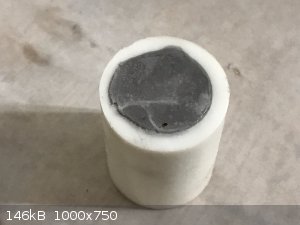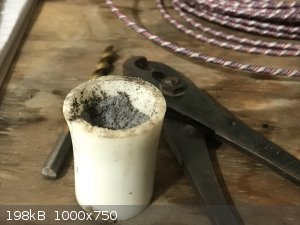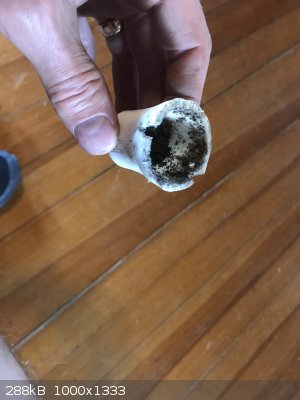Hey Buddy
Hazard to Others
  
Posts: 426
Registered: 3-11-2020
Location: Bushwhacker Country
Member Is Offline
|
|
Nitroguanidine Melt Castable Eutectics
I wanted to keep track of some NQ based melt cast formulation attempts.
From Urbanski:
"NGA"
NQ 17.5 %
Guanidium Nitrate 22.5 %
Ammonium Nitrate 60 %
This eutectic melts around 115 C.
The eutectic melts easily but is hygroscopic after hardening.
I attempted to use standard 1" PEX line cut to 1.5" filled with the melt cast.
It "weeps" water after drying at the exposed ends in as little as two hours or so.
Due to the found hygroscopicity, this melt cast became lower interest. I experimentally added +20% Aluminum which seemed to improve pourability and
workability for casting.

I attempted to detonate this material with .5 g of NAP. It failed to detonate. This melt cast is highly insensitive and probably has a large critical
diameter greater than 1". I found chunks of the melt cast buried in the ground which did not detonate.

|
|
|
underground
National Hazard
   
Posts: 702
Registered: 10-10-2013
Location: Europe
Member Is Offline
|
|
NQ QN and AN are all insensitive, you have to add some sentisizers like NM or ETN
|
|
|
Hey Buddy
Hazard to Others
  
Posts: 426
Registered: 3-11-2020
Location: Bushwhacker Country
Member Is Offline
|
|
The NQ eutectics are insensitive, for munitions. Not meant to be sensitive. Most common is TNT/NQ, but that is somewhat less practical. Most of the
development of these was done by war-time Germany for AP tank munitions.
Melt castable secondaries like TNT are uncommon, so insensitive high explosive eutectics are useful but not well known. They will detonate when fired
appropriately by booster, but the critical diameter has to be reached. I'm only testing their properties because they are not known. I've read about
them on SM but never seen any testing of them. Urbanski just lists some formulations and the war-time data is not available. This formulation is the
lowest depressed mp eutectic out of the known ones. I will test those others too and try a couple formulations of my own. I'm assuming the firing
failure here is most likely a critical diameter issue along with the added fuel which desensitizes it further. It is not a problem that a cap doesn't
set it off. It needs a larger critical diameter, probably more like 4 or 5" and a booster like PETN. It is a problem that it is hygroscopic because it
requires sealing and could go through phase changes.
|
|
|
underground
National Hazard
   
Posts: 702
Registered: 10-10-2013
Location: Europe
Member Is Offline
|
|
You can try to add a few % of Cuo into that mix, it will sentisize it for sure.
|
|
|
MineMan
International Hazard
    
Posts: 1004
Registered: 29-3-2015
Member Is Offline
Mood: No Mood
|
|
Definitely, especially if aluminum is in the mix.
AP and hexamine is an extremely powerful and dense eutetic, but requires higher temperatures, it’s an idea I have for rocket fuel without containing
a binder  . But carful. If you mix aluminum it can DDT with milligram quantities.
So don’t mix aluminum in with it!!! . But carful. If you mix aluminum it can DDT with milligram quantities.
So don’t mix aluminum in with it!!!
|
|
|
Hey Buddy
Hazard to Others
  
Posts: 426
Registered: 3-11-2020
Location: Bushwhacker Country
Member Is Offline
|
|
You want it to be insensitive. It is for filling cavities. Being insensitive lets you handle it as opposed to say, ETN, which is really not safe for
pouring. If you want an 8 km melt cast explosive that is melted in place, which also detonates small critical diameter, using a blasting cap, that
bill fits ETN perfectly.
I attempted a Pb NATz cap also. It also didnt initiate. These charges are buried and tamped and the pex is bendable which is why it still remains
intact after firing. This mix NGA is not ideal, IMO because of the hygroscopicity. I only added aluminum for thermobaric pressure curve in the case
that it did detonate. I believe the NGA likely has a larger critical diameter above 1" threshold. Similar to propyl-nitroguanidine, several inches. It
is common trait for NQ explosives. I will try next NQ/NH4NO3 and NQ/GuNO3 which each also form a eutectic at higher temp.

|
|
|
underground
National Hazard
   
Posts: 702
Registered: 10-10-2013
Location: Europe
Member Is Offline
|
|
Try to add a booster like 2-3 g of ETN / PETN
|
|
|
Hey Buddy
Hazard to Others
  
Posts: 426
Registered: 3-11-2020
Location: Bushwhacker Country
Member Is Offline
|
|
Im looking at the remainder of this NGA charge and it is no longer weeping fluid like a hygroscopic material. Im suspecting now it's not actually
hygroscopic and there was some sort of liquid evacuating itself out of the dried cast.
|
|
|
dettoo456
Hazard to Others
  
Posts: 235
Registered: 12-9-2021
Member Is Offline
|
|
What about alkyl-NQ derivatives? PrNQ is well known for its melt cast potential (a little over 100C mp if I remember correctly), but the MeNQ &
EtNQ work well also (mp between 100-150C). They are made fairly easily through rxn of the alkylamine with NQ in H2O and vacuum to pull off excess NH3
- decent yields as well. TNX compositions may also work - that being 1,3,5-trinitrosotriazine with NQ. I don’t know how the Nitroso groups would
interact with nitramines in the molten state though, it might react fairly readily.
The NQ/AN/GN comps you’re working with are basically airbag inflators without the pinch of RDX that auto manufacturers add, so their designed to be
extremely insensitive and not necessarily brisant/powerful.
PVN/NQ might be interesting, it wouldn’t be a melt cast or very powerful, but instead a sort of benign, thermoplastic EM. Ex&F’s video with
PVN might be of interest in that case.
[Edited on 13-5-2023 by dettoo456]
|
|
|
Hey Buddy
Hazard to Others
  
Posts: 426
Registered: 3-11-2020
Location: Bushwhacker Country
Member Is Offline
|
|
I casted three more of these cylinders with NGA, just to be sure of what was going on. I also added PETN as a sensitizer in the ratio of 80/20
NGA/PETN. All three were wet on their ends, definitely hygroscopic. All three detonated with 100 mg NAP.
The other two cast formulations have melt temps at ~130 C and ~160 C. That rules out PETN as a sensitizer because of its dec point. This is obviously
the reason for advancement in explosives (historically) following RDX, the dec point increases to 200 C+ which gives much more latitude.
NGA/PETN was pretty interesting. If only it was not hygroscopic. If the NQ/AN or NQ/GuN are non hygroscopic, they could be useful with another higher
temp sensitizer. I think K-6 is around 180 C dec point IIRC. ANQN could be another interesting filler...
I have considered pr-NQ but a direct eutectic from a base material would be ideal, IMO. The idea being that if you were casting larger shots, or
greater number of shots, it is easy to make NQ in quantity, but pr-NQ requires two additional operations: propylamine and pr-NQ. The real advantage of
NQ eutectic is simply heating NQ together with another oxidizer for casting operation.
There really arent that many materials to choose from. Glycine perchlorate is another material I have in mind as a high performance cast substrate.
But pr-NQ might be most logical in the end...
I had never heard about NQ eutectics being inflator compositions. Are you certain they are not brisant/powerful eutectics? --I suspect the NQ based
eutectics are fairly decent performance. I would guess they are at least on par with TNT. I haven't measured it though. From blasting with them and
cratering, it seems to be comparable to equivalent masses of TNT, approximately. Possibly a little more powerful than TNT. Not certain... Regardless,
the hygroscopicity and higher mps are discouraging. PETN casted-in fine but it was close to its dec point. I also tried an experimental urea/NGA/PETN
cast mixture, but it didn't seem to depress mp and the urea started to degass nitrogen bubbles in the casting.
I will try the other two classic mixtures to see if they are non-hygroscopic, if so then a high temp sensitizer/filler might be worth while...
|
|
|
Hey Buddy
Hazard to Others
  
Posts: 426
Registered: 3-11-2020
Location: Bushwhacker Country
Member Is Offline
|
|
Additional NQ eutectics
I have now attempted the other two reported known eutectics of NQ. These ratios are reported by Urbanski and Skrzynecki.
The first is:
NQ 20%
NH4NO3 80%
m.p. 131.5 C
I found this eutectic to be difficult to work with. The reported 131.5 C mp is only technically correct as m.p.
At ~131 this eutectic borderlines on solid/liquid phase. It inconveniently passes back into solid phase during melting until the temperature is raised
to about 160 C. At that point (160 C), it begins to truly become a workable melt cast. Unfortunately nitrogen oxide gasses can be smelled and their
bubbles seen in the melt by the time it reaches 160 C. I'm not sure how decomposed the ammonium nitrate becomes at that point, but it seems to cast
well enough to be useable. It does have shrinkage that is not present in NGA.
It appears that AN/NQ is not hygroscopic, which is good.
The second remaining formulation is:
NQ 41%
CH5N3*NO3 59%
m.p. 166.5 C
This one proved to be unreliable. I was not able to achieve a melt phase at all, but took the temperature up to 180 C, which in my opinion is the
maximum limit of useable melt-cast salts.
My judgement so far on these three formulations is that NGA is the most workable, but is hygroscopic, which is undesireable. AN/NQ appears to be non
hygroscopic at first glance, but has a higher mp than the claimed 131 which puts it at the extreme end of useability because of the off gassing of AN
at those temps. Obviously the GuNO3/NQ was not even useable. I did attempt out of curiosity to blend in some basic copper nitrate in hopes that this
would somehow drop the m.p. but it was no use, the mixture remained a powder in solid phase.
|
|
|
Hey Buddy
Hazard to Others
  
Posts: 426
Registered: 3-11-2020
Location: Bushwhacker Country
Member Is Offline
|
|
The NQ/AN eutectic is verified to be non-hygroscopic. I will go back to NGA and repeat some castings to verify if that is actually hygroscopic or
simply weeping, over the period of several days.
|
|
|
Hey Buddy
Hazard to Others
  
Posts: 426
Registered: 3-11-2020
Location: Bushwhacker Country
Member Is Offline
|
|
Quote: Originally posted by Hey Buddy  | | The NQ/AN eutectic is verified to be non-hygroscopic. I will go back to NGA and repeat some castings to verify if that is actually hygroscopic or
simply weeping, over the period of several days. |
The NQ/AN is double verified to actually be hygroscopic and it goes through symptoms of hygroscopicity only depending on ambient conditions. Ive had
the sample stored in open air the whole time. Sometimes it doesn't weep, sometimes it weeps. I thought it was somehow non-hygroscopic mistakenly. That
would be very unusual for an NH4NO3 mix. But it was hygroscopic for sure. These melt casts from NQ with AN are similar to ammonals and amotals but
with higher mp. The advantage would be the quick prep of NQ vs TNT.
|
|
|